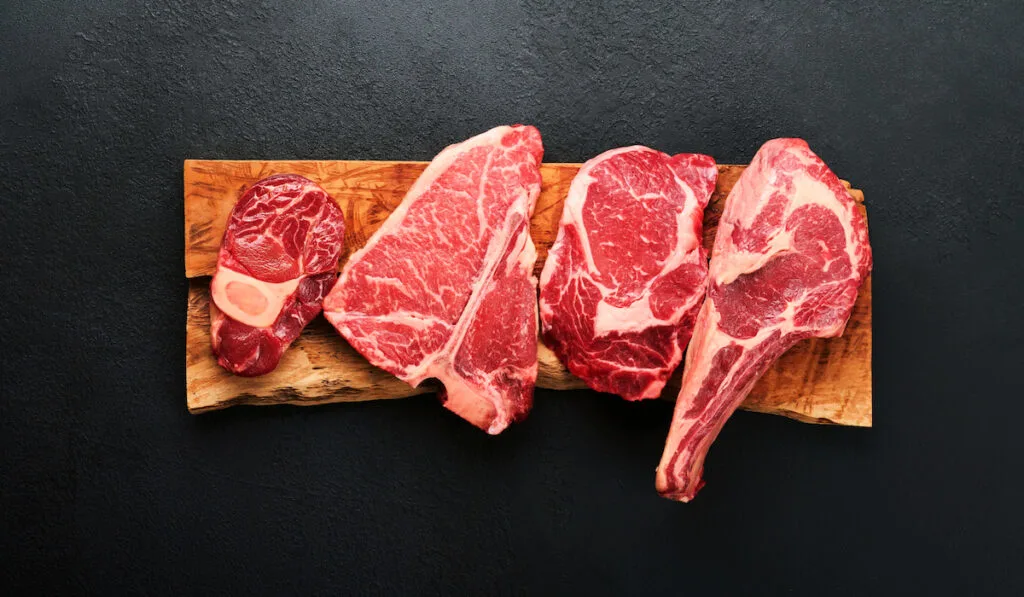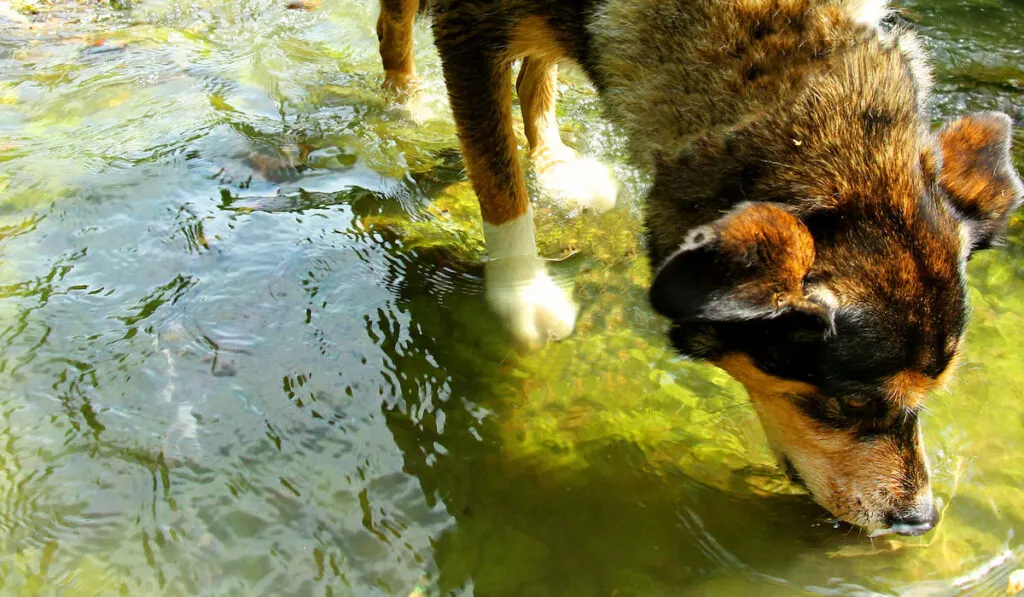You may have heard the term coydog and wondered what it meant.
Well, a coydog is a hybrid animal made from a dog and coyote parentage. In other words, a coydog is the offspring of a dog and a coyote.
While some people believe coydogs exist. Some do not. In all actuality, they do exist, although they are rare.
Coydogs can be formed from coyotes and various types of dog breeds.
The rarity of coydogs is due to the differing breeding season of the parent-canine species. Some dog breeds go into heat twice a year, and that makes interbreeding possible.
More commonly, but not limited to huskies and spitz dog breeds.

There are many possible blends of coydogs. But in this article, we focus on the coyote-lab mix.
We discuss this hybrid under the following headings:
Table of Contents
Size
The size of a coyote lab mix is dependent on the size of the parent dog. In general, coydogs stand at around 22 to 27 inches tall while weighing about 60 to 120 pounds.
Since the average Labrador retriever stands at around 21.5 to 24.5 inches, you can expect a coyote lab mix to fall within this range.
Also, labs weigh around 55-80 pounds. So, a coyote lab mix will be closer to this range.
Color
The color of a coydog is typically brown, sable, or white.
It may also be tan or grey. Coydogs, including coyote-lab mix, may have a white face mask like coyotes.
But the overall color depends on the parent dog.
Labradors mainly come in 3 colors: black, yellow, and chocolate. So a coyote-lab mix will most likely come in sable, brown, or tan.
Temperament (Are They Dangerous)
The temperament of coydogs is pretty diverse.
In the same vein, that of the coyote-lab mix is also diverse. Even coyote-lab mixes from the same litter can have significantly different temperaments.
One coyote-lab mix might be very gentle, while another is quite aggressive.
So, their temperament is unpredictable. This is the main reason why it is not advisable to keep them around family.
A coyote-lab mix may not be as cooperative as purebred Labradors are. Thus, they may not tolerate living with other animals.
They can be shy, gentle, fearful, or aggressive, especially around visitors.
One minute, they could be shying away from your visitor. Then the next, they could be displaying aggression towards the said visitor.
Their display of aggression towards visitors is usually a show of the territoriality they may have inherited from the coyote parent.
Coyote-lab mixes can be strong-willed and may be hard to control for inexperienced dog handlers. They are best handled by someone who is firm and understands canid behavior.
Besides this, in the absence of a firm handler, they will readily switch alliances.

They are opportunistic, hence, their disloyalty. However, an alpha handler or owner would have no problem managing this behavior.
Generally, a coyote-lab mix should be agile, alert, intelligent, and independent.
But they can also be clownish, friendly, and active. This is more likely if the traits of the parent Labrador predominate.
Are they dangerous? Well, a coyote-lab mix can be a source of threat to anyone.
As said earlier, they are unpredictable. So, you may not know what to expect from them until they finally show their true nature.
But generally, a coyote-lab mix with more coyote traits than lab traits will likely be dangerous.
One habit you may notice in coyote lab mixes is their gaping. Unlike purebred labs that snarl, this mix gapes like coyotes.
Trainability
Coyote-lab mixes, being as intelligent as they are, are trainable.
But they can also be hard to train, especially if it is your first time with a canid. If you do not handle the coyote lab mix properly, it may not listen to you.
For one, if you show fear around it, it will not heed your words or respect you.
This is why being firm is particularly vital while handling coyote lab mixes. In being firm, be strict but ensure that you are not harsh while correcting them.
Also, if the coyote’s wild instinct is predominant in your coyote-lab mix, training might be difficult.
If you intend to train a coyote-lab mix, it is best to start while they are young. While young, their personality is still malleable, and they can learn readily.
If you have not had any experience with a hybrid animal before, get an experienced handler to train your dog.
While training a young coyote-lab mix, socialization is vital.
Group puppy classes would be great. But not many facilities take in hybrids. Nonetheless, if there are other dogs around, let the coyote-lab mix interact with them under supervision.
When training your coyote-lab mix, start with obedience training.
Let them respond to simple commands such as go, sit, and stop. Then with time, you may move to grooming, exercising, and bathing.
While training, ensure you institute rewards and retributions. Also, be consistent, and keep the sessions short, or they will get bored.
Going 5 to 10 minutes per training session should be enough.

Health Considerations
Coydogs are generally considered to be hardy and agile.
But being a mix of two different species, the health considerations of a coydog will depend on the coyote and dog parentage.
For coyote-lab mixes, their health considerations depend on those of a coyote and a Labrador retriever.
Overall, Labradors are healthy, but they are prone to a few diseases, including the following:
- Cataracts
- Progressive Retinal Atrophy
- Hip Dysplasia
- Elbow Dysplasia
- Epilepsy
- Osteochondrosis Dissecans
- Acute Moist Dermatitis
- Bloat
- Myopathy
- Tricuspid Valve Dysplasia
- Cancer
- Obesity
Coyotes, on the other hand, are prone to the following health conditions:
- Mange
- Heartworm
- Rabies
- Canine Parvo
- Hydatid Disease
- Canine Distemper
A coyote-lab mix may be prone to any of the health conditions listed above.
Fortunately, all health conditions listed above for coyotes are preventable.
Some can be prevented with vaccines, while others can be prevented by keeping your mix away from infected animals.
What to Feed Them
Coydogs are typically large and are generally highly active.

Due to their activity and size, they need high-energy foods.
But considering that Labradors are highly active, the feeding requirements of a coyote-lab mix may be slightly higher than that of a regular coydog.
While a coyote lab mix will survive if fed high-quality dog food, they do better on a raw-meat diet.
So, instead of high-energy dog kibble, the mix’s diet should consist mainly of raw meat. This can be raw chicken, raw beef, raw bone, or raw meat of other animals.
You may supplement this diet with high-energy dog food.
In feeding your coyote-lab mix, try to control their portions.
Remember Labradors are prone to obesity. All in all, you should speak with a vet experienced with hybrid dogs for more details on what to feed it.
How to Know if Your Dog Is Truly a Coyote Mix
A DNA test is the most definitive way of knowing if your dog is a coyote mix.

But in the absence of the test, you can look out for the following signs:
- Pointy Muzzle – coydogs typically have pointed black muzzles. So, if you notice your dog has a similar muzzle structure, it may be a coyote mix.
Of course, this sign is not definitive since some dog breeds have pointy muzzles under normal circumstances.
You may compare your dog’s nose to that of other members of the breed it is thought to belong to. If it is pointier than usual, you may suspect that it is a coyote mix.
- Slenderness – generally, coyotes are slimmer than dogs, and they have long legs. So, if you notice that your dog is skinnier than average and has longer legs, it may be a coyote mix.
- Flatter Forehead – another early sign you may see in a possible coyote mix is a flatter forehead.
The forehead of a coyote is flatter than that of a dog. So, a dog that is a coyote mix may have a flatter forehead than usual. - Droopy Tail – this sign is uncommon, but it is a helpful sign in verifying if your dog is a coyote mix.
Coyotes typically have flaccid tails, while those of dogs are usually upright. So, if you notice that your dog has a drooping tail, it might be a coyote mix.
None of the signs above are definitive, and this is why a DNA test is the best means of verifying your suspicion.
Nonetheless, if you notice a combination of any of the signs, then your dog may most likely be a coyote mix.
Before concluding, keep in mind that coyote dog mixes are rare, and these signs are not conclusive.
Resources
- https://www.dogmal.com/coydog/
- https://dogable.net/coyote-dog-mix-coydog/
- https://www.akc.org/dog-breeds/labrador-retriever/
- https://doggiedesigner.com/coydog/
- https://blog.nationalgeographic.org/2014/04/08/your-weird-animal-questions-answered-is-your-dog-part-coyote/
- https://bornforpets.com/2020/09/05/is-my-dog-part-coyote/
